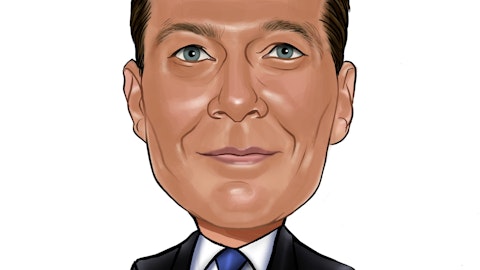Mike Harrison: All right. Thanks for that. And then, Kevin, you mentioned the lower variable comp and lower equity-based comp that you saw year-on-year in Q1. When does that variable comp maybe flip to being a headwind year-on-year? And I guess for the full year, how much higher should we expect variable comp and merit or cost of living increases to be for the full year?
Kevin Willis : Yes, merit is already flowing through. We change merit. We change merit first of the year. So call it January is when that is that’s flowing through. All that’s anticipated and contemplated in the outlook. In terms of the Q1, most of that is equity-based comp. A very small portion of that is annual incentive comp. So it’s more of the equity piece. I would expect the corporate side of the equation to return to call it more normalized levels, Q2 through Q4, time frame. The year-over-year difference from a merit and incentive comp perspective, it’s about $25 million for incentive comp year-over-year, and about $15 million would be the merit increase impact year-over-year. So those two things would be roughly $40 million higher this year than last year at target.
And so you won’t see all of that [inaudible] a big chunk of that goes through COGS because it’s related to plants in terms of both the annual incentive and the merit increase. Most of our employees are actually in the plants. So it’ll flow through various places in the P&L, but that’s the number.
Operator: Our next question comes from Christina Lowe with JP Morgan.
Jeff Zekauskas: Hi, this is Jeff Zekauskas. Can you hear me? Okay, good. Thank you. Is the intermediate consultants business getting better or worse if you have visibility on that?
Guillermo Novo: No, it’s been stabler. I mean, most of the volume drops have happened in last year. So even if you, obviously a big impact quarter on, year-on-year and quarter-on-quarter in the last versus ‘23, but still is performing better than it did historically. So I think the two things we need to look at, it’s performing better historically, because we have refocused it, we’re focused on different regions where we have competitive advantage. Most of the stuff now is going into EV batteries, semiconductors, coatings, high quality segments, US, Europe, we obviously do sell still a little bit in Europe and the electronic side. And that’s that slowdown for us because it’s just the competitive intensity. So if you look at the slowdown, there’s two sides to it.
There’re our markets, and then there’s the BDO dynamic. BDO, we don’t, we’re not a big player there. But BDO prices have come down a lot more because of the commodity markets and or urethane fibers, all these other markets. So there’s an excess, especially in Europe of raw material, BDO prices come down. So a lot of the NMP and BLO producers have a lower cost base right now. So there’s a lot more aggressive positioning for loading volumes and things of that nature coming from Asia. The issue is we’ve seen it mostly on volume, we’re seeing some pricing, but we’re still being able to maintain a better position. I think the issue now is as volumes start recovering, not just in our markets, the EV, the semiconductor spaces, picking up again in the regions that we’re focusing on will be good, but really as the trend we’re seeing applies to other companies later on in terms of some of the more commodities and BDO prices start coming up that also will change a little bit of the dynamics in our spaces.
So you got to look at both of those, that cost implication of BDO and the demand within our own markets as big drivers, because it’s more of a commodity, it’s not as differentiated as other parts of our portfolio.
Jeff Zekauskas: Your unallocated costs were $16 million in the quarter. Is that the normal run rate for you now? And is there any meaningful share issuance? I know you put back a $100 million worth of stock. Are you issuing any shares to different plans?
Guillermo Novo: So I’ll start with kind of the unallocated. Unallocated in Q1 was light primarily because of equity-based comp. I would say the more normalized level that we expect to see and what we would have in our outlook is more like around $20 million a quarter for the balance of the fiscal year. In terms of the share we purchase, there’s been no meaningful change in what we do there in terms of, yes, when we buy those shares, we retire them. And so there’s no other use that we’re applying those to. So right now as we stand today, total share count is around 50 million based on the repurchase of those shares. The weighted average for the quarter is higher than that because we repurchase during the quarter. But we’ll do a couple hundred thousand shares a year for comp-based things, but nothing’s changed with that.
Jeff Zekauskas: And then lastly, I may have been muddled over your earlier discussion. Your revenue forecast for the March quarter is $565 million to $585 million. And your revenues in 2023 in the March quarter were $603 million. And you talked about the orders being much stronger than you expected, though I don’t what your expectations actually were. So you talked about how important March was. So in that $565 million to $585 million, we’re expecting volumes to be generally lower year-over-year in the March quarter, is that right? And that’s the current pattern for the first two months too, or March is really different.
Kevin Willis : I would say we do expect volumes to be a little bit lower in this March quarter versus last March quarter. And again, that’s based on the best look that we have. March could change that. I mean, I think we’re looking probably low single digits year-over-year from a comparison perspective on volumes. And the other dynamic that’s coming into play is the price mix piece. As we said in our comments, there is some interplay there around price, raw materials and volumes. And so we’re trying to make sure that we strike the appropriate balance as we do compete for some volume in the marketplace as demand has more normalized right now. So it’s really going to be a combination of all those factors.
Jeff Zekauskas: What was the volume comparison in January?
Kevin Willis : We haven’t closed January yet, so we’ve got to see that.
Guillermo Novo: Yes, I was going to say, we don’t know yet. It’s still the order. The order book, I mean, look, it was significantly stronger and normalizing a little bit more. I think we need to look, get back to you with some comments on, with February, remember last year, we’re also looking at China and all the things that were happening. So we’re trying to look at some of those comparison on a quarter-on-quarter. I think what we’re seeing right now is the sequential, the momentum of improvement. I think the biggest challenge right now is to forecast inflections. When things are good and they turn down, it’s very difficult to forecast. And now when things were down, if we’re starting to really see an inflection of changing, I think that’s the really bigger focus for us right now.




